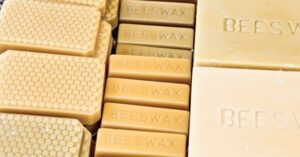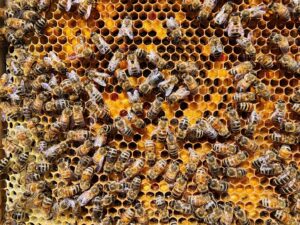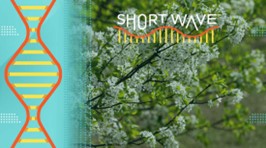by Dewey M. Caron, Communications and Content Specialist for the Oregon Master Beekeeper Program
Mind Your Beeswax
 For Earth Day last month Dadant presented a Deep Dive into Beeswax – science and uses.
For Earth Day last month Dadant presented a Deep Dive into Beeswax – science and uses.
Beeswax is one of nature’s most fascinating creations, with a history stretching back thousands of years. Used by ancient civilizations for everything from waterproofing to candle making, this natural material continues to astound us with its versatility and utility. But how many of us truly understand what beeswax is, how it’s made, and why it remains such a valuable resource today?
This blog takes an in-depth look at the science behind beeswax, its unique properties, and the various ways it’s used. Whether you’re a beekeeper curious about this part of your hive or a consumer looking for different ways to use beeswax, this guide will satisfy your curiosity.
What Is Beeswax?
Beeswax is a natural substance created by worker honeybees. These bees have special glands, known as wax glands, on the underside of their abdomen that releases a liquid wax composed of fatty acids, long-chain alcohols, and other components. Though the wax is a clear liquid when the bees first make it, air exposure causes it to solidify into hard scales ranging from a yellow to brown color.
Read the full article here: https://www.dadant.com/a-deep-dive-into-the-science-behind-beeswax-its-uses/
Potential Risk to Pollinators from Nanotechnology-Based Pesticides
 Louisa A Hooven, Priyadarshini Chakrabarti , Bryan J Harper, Ramesh R Sagili, Stacey L Harper PMCID: PMC6943562 PMID: 31817417 https://pmc.ncbi.nlm.nih.gov/articles/PMC6943562/
Louisa A Hooven, Priyadarshini Chakrabarti , Bryan J Harper, Ramesh R Sagili, Stacey L Harper PMCID: PMC6943562 PMID: 31817417 https://pmc.ncbi.nlm.nih.gov/articles/PMC6943562/
Abstract
The decline in populations of insect pollinators is a global concern. While multiple factors are implicated, there is uncertainty surrounding the contribution of certain groups of pesticides to losses in wild and managed bees. Nanotechnology-based pesticides (NBPs) are formulations based on multiple particle sizes and types. By packaging active ingredients in engineered particles, NBPs offer many benefits and novel functions, but may also exhibit different properties in the environment when compared with older pesticide formulations. These new properties raise questions about the environmental disposition and fate of NBPs and their exposure to pollinators. Pollinators such as honey bees have evolved structural adaptations to collect pollen, but also inadvertently gather other types of environmental particles which may accumulate in hive materials. Knowledge of the interaction between pollinators, NBPs, and other types of particles is needed to better understand their exposure to pesticides, and essential for characterizing risk from diverse environmental contaminants. The present review discusses the properties, benefits and types of nanotechnology-based pesticides, the propensity of bees to collect such particles and potential impacts on bee pollinators.
New bee feed
 WSU scientists develop ‘Power Bars’ to help honey bees survive.
WSU scientists develop ‘Power Bars’ to help honey bees survive.
A new honey bee food source, developed by scientists at Washington State University and APIX Biosciences NV in Belgium, could combat escalating rates of colony collapse. The food source can sustain honey bee colonies without pollen. The innovation, which took more than a decade of work is targeted for commercial release in mid-2026.
Trials with nutritionally stressed colonies deployed for pollination in Washington were published April 16 in the journal “Proceedings of the Royal Society B.”, Thierry, Taylor Reams, Isabelle Maillet, Kelly Kulhanek, Maarten Duyck, Frank Eertmans, Anne Marie Fauvel, Brandon Hopkins and Jan Bogaert. 2025. A nutritionally complete pollen-replacing diet protects honeybee colonies during stressful commercial pollination—requirement for isofucosterol, Article ID:20243078. https://doi.org/10.1098/rspb.2024.3078.
Brandon Hopkins says “This is the closest thing to an equivalent to actual pollen.” A key component of the product is isofucosterol, a molecule found naturally in pollen that acts as a vital nutrient. Colonies fed with isofucosterol-enriched food survived an entire season without pollen access, while those without it experienced severe declines (as we might expect). Trials occurred in colonies in blueberry and sunflower fields, both known for poor pollen quality for bees. Tim Hiatt, a Washington State Beekeepers Association board member said other livestock categories have had man-made feeds for many years but “Beekeepers have never had a protein that could completely replace natural pollen….If this feed would take the place of missing forage, it would be of huge benefit to our hives’ health.
Stored pollen (bee bread) in frame Photo by Elaine Timm
Flowers and trees are blooming earlier. Is it because of climate change?
 Maybe you are aware (and/or keep records) that flowering dates of honey bee flora seem to have come early this spring. Was it an earlier spring for flowering plants where you keep your bees? Short Wave shortwave@npr.org, a monthly NPR radio broadcast that answers local environment listener questions, on April 22, 2025 answered a question of Shai Tsur, of Okland CA, wanting to know why his Callery pear tree started blooming … in January
Maybe you are aware (and/or keep records) that flowering dates of honey bee flora seem to have come early this spring. Was it an earlier spring for flowering plants where you keep your bees? Short Wave shortwave@npr.org, a monthly NPR radio broadcast that answers local environment listener questions, on April 22, 2025 answered a question of Shai Tsur, of Okland CA, wanting to know why his Callery pear tree started blooming … in January
Richard Primack, a professor of plant ecology at Boston University says: ” Plants are flowering earlier, trees are leafing out earlier.…and the reason that they’re flowering earlier [is] because it’s warmer.” He bases this statement on plant phenology records. Chris Daly, Professor of Chemical, Biological and Environmental Engineering, lead author of the USDA plant zone hardiness maps and director of the PRISM spatial climate analysis group [https://prism.oregonstate.edu/] at Oregon State University offered a local perspective: “Here in the Northwest, we’ve seen a definite trend towards warmer and drier summers…..We already get very little precipitation in July and August, but even that’s dwindling.”
PRISM publishes regular climate information. These are publicly accessible maps that track weather conditions and precipitation levels around the country, average them out and then show how those averages have shifted over time. Comparing normal climate over time, Chris says “ it’s clear that temperatures are rising across the United States”. NOTE: Citizen scientists can contribute climate data as a observer via the app, Nature’s Notebook of the USA National Phenology Network.